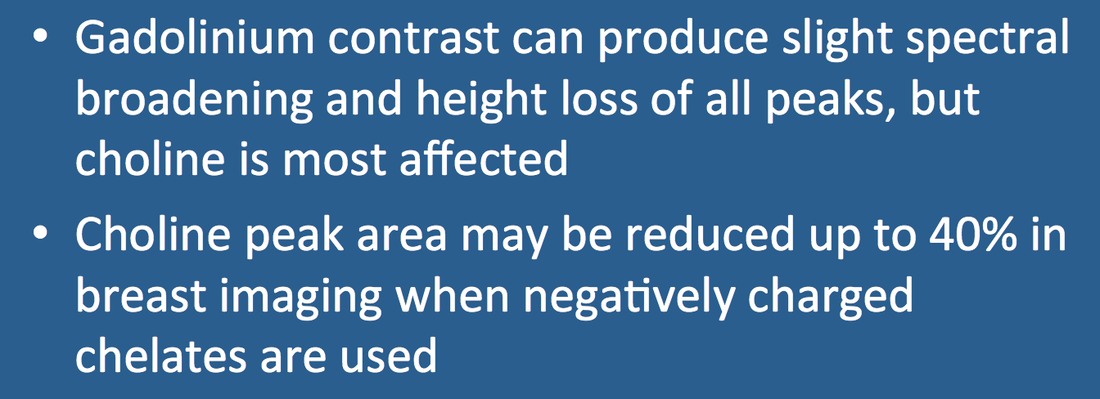|
In body imaging gadolinium contrast rapidly accumulates in both normal and abnormal tissues and its effects are greater. In breast imaging, for example, gadolinium may reduce the area under the choline peak as much as 40%. Because the N-methyl group of choline is postitively charged, this phenomenon is more prominent when negatively charged chelates (such as Magnevist, MultiHance, and Dotarem) are used instead of neutral ones (e.g., Omniscan, ProHance).
|
Advanced Discussion (show/hide)»
The relatively stronger effect of ionic gadolinium agents on choline compared to other metabolites may be at least partially explained by electrostatic forces. Specifically, the protons responsible for the Cho resonance at δ=3.2 are located on positively charged N-methyl groups. This positive charge may facilitate interaction with negatively charged gadolinium chelates. By comparison, NAA has a net negative charge, so should repulse (not attract) a negative gadolinium chelate. The effect on creatine is variable. The primary Cr resonance at δ=3.0 derives from protons on the positively charged N-methyl group of creatine and from those on the negatively charged creatine phosphate. Hence the relative amounts of creatine and creatine phosphate may determine the amount of interaction with a gadolinium complex.
Lin AP, Ross BD. Short-echo time proton MR spectroscopy in the presence of gadolinium. J Comput Assist Tomogr 2001; 25:705-712.
Lenkinski RE, Wang X, Elian M, Goldberg SN. Interaction of gadolinium-based MR contrast agents with choline: implications for MR spectroscopy (MRS) of the breast. Magn Reson Med 2009; 61:1286-1292.
Murphy PS, Dzik-Jurasz AS, Leach MO, et al. The effect of Gd-DTPA on T1-weighted choline signal in human brain tumours. Magn Reson Imaging 2002; 20:127–130.
Sijens PE, van den Bent MJ, Nowak PJCM, et al. ¹H chemical shift imaging reveals loss of brain tumor choline signal after administration of Gd-contrast. Magn Reson Med 1997; 37: 222–225.
Smith JK, Kwock L, Castillo M. Effects of contrast material on single-volume proton MR spectroscopy. AJNR Am J Neuroradiol 2000; 21: 1084-1089.
How do you perform breast spectroscopy? What do the peaks mean?

